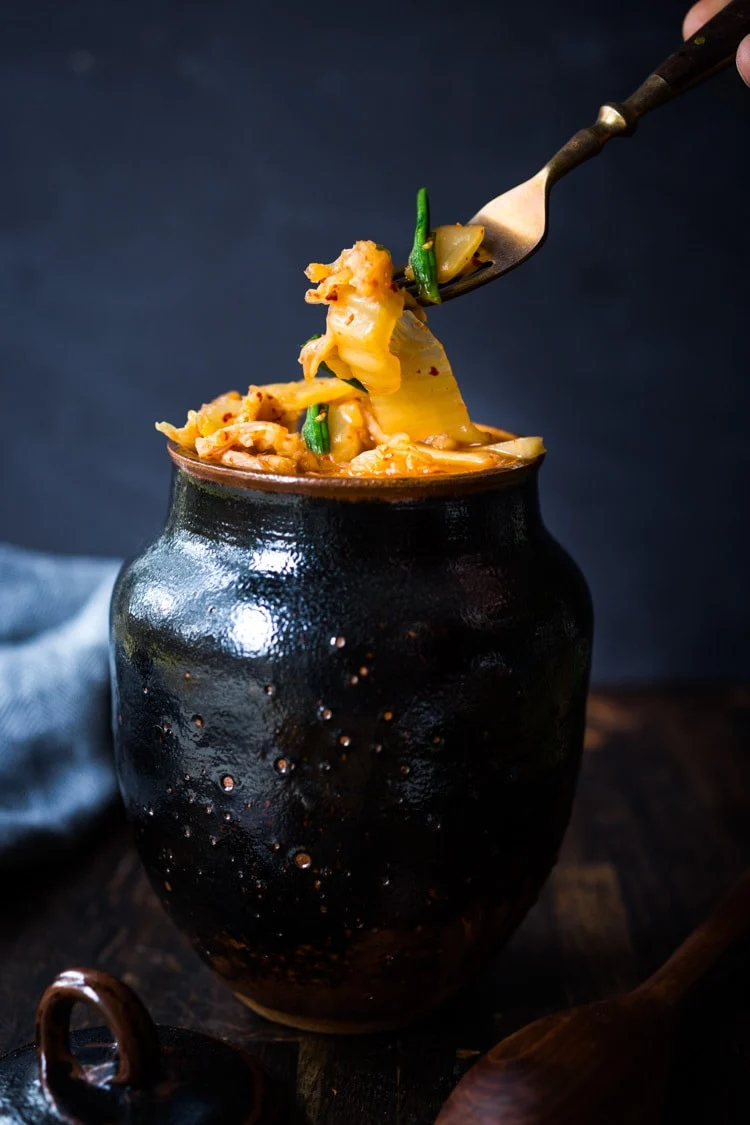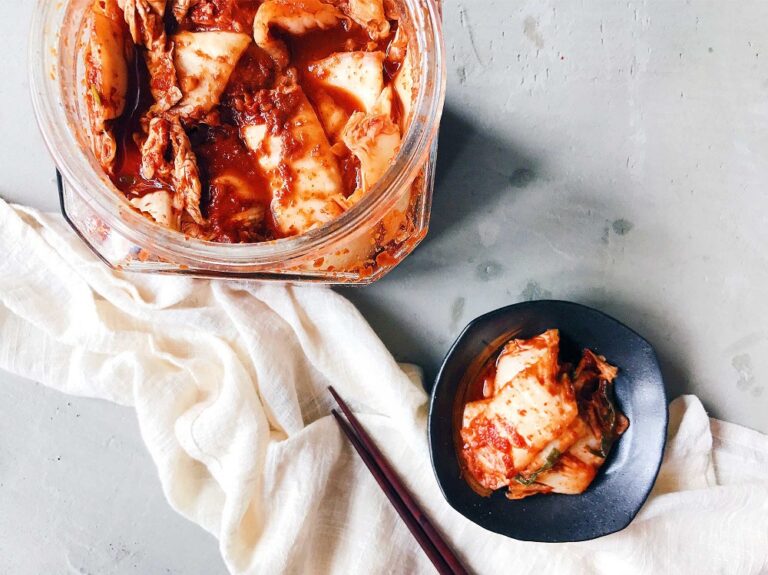How to Prepare Kimchi
With just 30 minutes of hands-on time, you can easily make this simple Kimchi recipe at home before Mother Nature takes over! This traditional kimchi is gluten-free, vegan-adaptable, and loaded with beneficial probiotics that support digestive health. You can customize the level of spice to suit your taste! include a video.
In essence, kimchi is fermented cabbage, prepared similarly to sauerkraut but flavored with fish sauce, garlic, ginger, and Korean chiles. The essence of Korean cuisine, kimchi is wonderful served with a variety of dishes.
Want to know the best thing about Kimchi? Kimchi is alive! Full of living, healthy, good bacteria or probiotics that support the gut, boost immunity, energize the body, and aid digestion, it is believed to fight cancer, lower cholesterol, and regulate blood sugar.

WHY YOU’LL LOVE THIS KIMCHI RECIPE!
- Simple ingredients. Familiar, whole-food ingredients like cabbage, spices, optional fish sauce, salt, dried Korean chilies, and sugar are called for here. Nothing processed!
- Vegan-adaptable. This recipe calls for fish sauce but can easily be made vegan. You can also leave out the sugar if you prefer.
- Incredibly nutritious! Kimchi is full of gut-healthy probiotics (specifically lactobacillus bacteria) that support a diverse gut microbiome. It also boosts the immune system, energizes the body, lowers cholesterol, and regulates blood sugar- along with so many other benefits!

KIMCHI INGREDIENTS
- Napa Cabbage: This is the main ingredient and the heart of the recipe. Opt for organic or locally grown. Yes, you can substitute other cabbage, but Napa Cabbage is traditional.
- Fine Sea Salt– salt is key to fermenting, inhibiting bad bacteria growth while promoting good bacteria.
- Ginger: Adds a fragrant and subtly spicy taste.
- Garlic: Aromatic and pungent, garlic is key to enriching the flavor.
- Scallions (green onions): Brings in a bit of onion-like flavor, crunchy texture and color!
- Daikon: Subtly sweet and crunchy, daikon radish adds substance and texture.
- Fish Sauce, Shrimp paste, or Miso paste: Adds salt, umami, and depth of flavor. Shrimp paste is traditional, but fish sauce and miso (vegan option) both work too.
- Korean Chili Flakes: We use dried chili flakes (called Gochugaru)here for the purest, cleanest flavor(no preservatives, oils, or flavorings). Feel free to sub Gochujang paste if you prefer.
- Optional: Glutenous rice flour can be added to thicken.
- Equipment: An 8-cup mason jar and a fermentation weight are handy.
This easy kimchi recipe makes enough to fill a large two-quart jar (about 8 cups).
KIMCHI VARIATIONS
Like so many things, there are so many variations to kimchi, and people have their own personal preferences. I just wanted to provide you with a starting point, and I’m sure you will adapt to your own tastes!
- Sugar is optional- some people add it, some don’t!
- Matchstick carrots would make a nice addition if you want more vegetables.
HOW TO MAKE KIMCHI (STEP-BY-STEP INSTRUCTIONS)
*See the recipe card and video below!
Step one: Save 1-2 outer leaves of napa cabbage and place them in the fridge while you prep the recipe. (You will use these later). Using a cutting board, cut the napa cabbage into 1-inch cubes with a sharp knife.

Step two: Place the chopped napa cabbage in a bowl and toss with 1/4 cup sea salt.

Step three: Fill the bowl with filtered water and stir, and soak the napa cabbage for 6-8 hours, stirring every couple hours.

Place plate over the napa cabbage to keep it submerged.

Step Four: After 6-8 hours, drain (making sure to save the brine) and rinse, pressing the liquid out.

Step Five: Make the Kimchi Paste
As I stated earlier, I prefer to use Korean Chili Flakes called “Gochugaru” vs. the Korean fermented Chili Paste called “Gochujang”. Feel free to use Gochujang if you please. Totally up to you. Either way, you will make the paste below.
Many people ask if they can use regular old chili flakes- yes, but they are much spicier!!! Gochugaru is fruitier and less spicy, so you can use more and get more flavor. You could try subbing dried Arbol Chilies if you absolutely can’t get the Korean Chili flakes – or even use fresh red chilies to make the paste.
In a food processor, make a paste with garlic, ginger, shallot, Korean chili flakes (or Gochujang) and optional fish sauce (or miso) and sugar. If you want a mild version, use half the chili flakes. The fish sauce really adds a delicious complexity and depth, but you can, of course, keep it vegan with miso paste.

Step Six: Peel and cut the daikon radish (or carrots) into match sticks, about 2-3 inches long. Cut the scallions.

Step Seven: Cut the scallions into 1-2 inch pieces.

Step Eight: Combine the Kimchi. Place the drained cabbage along with the daikon, scallions and chili paste into the bowl. Massage the cabbage with gloved hands.
FYI: This is a very mild version shown below, so not very red in color, (2 tablespoons chili flakes). You can add more chili flakes if you want it spicier – I normally add 4-6 tablespoons.

Step Nine: Pack the Kimchi.
Pack tightly into a large two-quart jar (half-gallon, 64 oz) or large crock. (Or use two, quart-sized mason jars.) You want a good two inches of space at the top to catch the flavorful liquid that will release.
TIP: I have had great success with this Fermentation Kit that has crystal weights that fit perfectly in a wide-mouth mason jar. It is so convenient for small-batch ferments. This fermentation kit includes the jars which is a great option too!

Cover with the cabbage leaf you saved in the fridge, and press down. Pour a little of the brine into the jar, just enough to cover the cabbage.

The cabbage leaf will help keep the chopped pieces of cabbage contained and submerged. Add a fermentation weight, pressing down to keep the cabbage leaf submerged under the brine. Anything that floats to the top and touches air can mold. So remove with a slotted spoon. Cover lightly with a lid (do not screw on tight) and place on a rimmed pan or bowl ( to collect any overflow).



